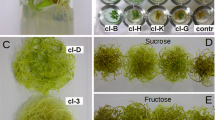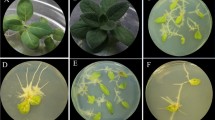Abstract
Using several explants of Pueraria candollei Grah. ex Benth. var. candollei and two strains of Agrobacterium rhizogenes (ATCC 15834 and 43057), hairy root cultures were established. Including 100 μM acetosyringone in the culture medium enhanced frequency of hairy root induction by up to 58 %. Subsequently, effects of inoculum size (IS) and temperature on growth and production of isoflavonoids in hairy roots were determined. Conditions of 1 % IS and 32 °C promoted the highest accumulation of total isoflavonoid content, up to 31.0 ± 22.6 mg/g dry weight (DW), in hairy roots. Moreover, culture of hairy roots at 32 °C decreased browning of hairy roots. Furthermore, this temperature promoted accumulation of the secondary metabolite daidzein; whereas, hairy root cultures at the stationary phase accumulated higher amounts of the isoflavonoid puerarin rather than daidzein.






Similar content being viewed by others
References
Boonsnongcheep P, Korsangruang S, Soonthornchareonnon N, Chintapakorn Y, Saralamp P, Prathanturarug S (2010) Growth and isoflavonoid accumulation of Pueraria candollei var. candollei and P. candollei var. mirifica cell suspension cultures. Plant Cell Tissue Organ Cult 101:119–126
Chandra S, Chandra R (2011) Engineering secondary metabolite production in hairy roots. Phytochem Rev 10:371–395
Chansakaow S, Ishikawa T, Sekine K, Okeda M, Higuchi Y, Chaichantipyuth C (2000a) Identification of deoxymiroestrol as the actual rejuvenating principle of “kwao keur”, Pueraria mirifica. The known miroestrol may be an artifact. J Nat Prod 63:173–175
Chansakaow S, Ishikawa T, Sekine K, Okeda M, Higuchi Y, Kudo M, Chaichantipyuth C (2000b) Isoflavonoids from Pueraria mirifica and their estrogenic activity. Planta Med 66:572–575
Cherdshewasart W, Sriwatcharakul S (2007) Major isoflavonoid contents of the 1-year-cultivated phytoestrogen-rich herb, Pueraria mirifica. Biosci Biotechnol Biochem 71:2527–2533
Cherdshewasart W, Sutjit W (2008) Correlation of antioxidant activity and major isoflavonoid contents of the phytoestrogen-rich Pueraria mirifica and Pueraria lobata tubers. Phytomedicine 15:38–43
Dehghan E, Häkkinen S, Oksman-Caldentey K-M, Shahriari Ahmadi F (2012) Production of tropane alkaloids in diploid and tetraploid plants and in vitro hairy root cultures of Egyptian henbane (Hyoscyamus muticus L.). Plant Cell Tissue Organ Cult 110:35–44
Furner IJ, Huffman GA, Amasino RM, Garfinkel DJ, Gordon MP, Nester EW (1986) An Agrobacterium transformation in the evolution of the genus Nicotiana. Nature 319:422–427
Gamborg OL, Miller RA, Ojima K (1968) Nutrient requirements of suspension cultures of soybean root cells. Exp Cell Res 50:151–158
Geng L, Niu L, Gresshoff P, Shu C, Song F, Huang D, Zhang J (2012) Efficient production of Agrobacterium rhizogenes-transformed roots and composite plants in peanut (Arachis hypogaea L.). Plant Cell Tissue Organ Cult 109:491–500
Georgiev M, Pavlov A, Bley T (2007) Hairy root type plant in vitro systems as sources of bioactive substances. Appl Microbiol Biotechnol 74:1175–1185
He X, Blount J, Ge S, Tang Y, Dixon R (2011) A genomic approach to isoflavone biosynthesis in kudzu (Pueraria lobata). Planta 233:843–855
Ingham JL, Tahara S, Dziedzic SZ (1986) A chemical investigation of Pueraria mirifica roots. Z Naturforsch C 41:403–408
Jeong GT, Park DH, Ryu HW, Lee WT, Park K, Kang CH, Hwang B, Woo JC (2002) Optimum conditions for transformed Panax ginseng hairy roots in flask culture. Appl Biochem Biotech 98–100:1129–1139
Jeong GT, Park DH, Ryu HW, Hwang B, Woo JC (2004) Effects of inoculum conditions on growth of hairy roots of Panax ginseng C.A. Meyer. Appl Biochem Biotechnol 116:1193–1203
Keung WM (2002) Pueraria: the genus Pueraria. Taylor & Francis, New York
Kintzios S, Makri O, Pistola E, Matakiadis T, Ping Shi H, Economou A (2004) Scale-up production of puerarin from hairy roots of Pueraria phaseoloides in an airlift bioreactor. Biotechnol Lett 26:1057–1059
Korsangruang S, Soonthornchareonnon N, Chintapakorn Y, Saralamp P, Prathanturarug S (2010) Effects of abiotic and biotic elicitors on growth and isoflavonoid accumulation in Pueraria candollei var. candollei and P. candollei var. mirifica cell suspension cultures. Plant Cell Tissue Organ Cult 103:333–342
Liu C, Zhu J, Liu Z, Li L, Pan R, Jin L (2002) Exogenous auxin effects on growth and phenotype of normal and hairy roots of Pueraria lobata (Willd.) Ohwi. Plant Growth Regul 38:37–43
Mathur A, Gangwar A, Mathur A, Verma P, Uniyal G, Lal R (2010) Growth kinetics and ginsenosides production in transformed hairy roots of American ginseng-Panax quinquefolium L. Biotechnol Lett 32:457–461
Murashige T, Skoog F (1962) A revised medium for rapid growth and bioassays with tobacco tissue cultures. Physiol Plant 15:473–497
Ozyigit II, Kahraman MV, Ercan O (2007) Relation between explant age, total phenols and regeneration response in tissue cultured cotton (Gossypium hirsutum L.). Afr J Biotechnol 6:3–8
Pietrosiuk A, Syktowska-Baranek K, Wiedenfeld H, Wolinowska R, Furmanowa M, Jaroszyk E (2006) The shikonin derivatives and pyrrolizidine alkaloids in hairy root cultures of Lithospermum canescens (Michx.) Lehm. Plant Cell Rep 25:1052–1058
Saleh NM, Thuc LV (2009) Assessment of hairy roots induction in Solenostemon scutellarioides leaves by different strains of Agrobacterium rhizogenes. Afr J Biotechnol 8:3519–3523
Sevόn N, Oksman-Caldentey KM (2002) Agrobacterium rhizogenes-mediated transformation: root cultures as a source of alkaloids. Planta Med 68:859–868
Sheikholeslam SN, Weeks DP (1987) Acetosyringone promotes high efficiency transformation of Arabidopsis thaliana explants by Agrobacterium tumefaciens. Plant Mol Biol 8:291–298
Shi HP, Kintzios S (2003) Genetic transformation of Pueraria phaseoloides with Agrobacterium rhizogenes and puerarin production in hairy roots. Plant Cell Rep 21:1103–1107
Shi HP, Long YY, Sun TS, Tsang E (2011) Induction of hairy roots and plant regeneration from the medicinal plant Pogostemon cablin. Plant Cell Tissue Organ Cult 107:251–260
Sidwa-Gorycka M, Krolicka A, Orlita A, Malinski E, Golebiowski M, Kumirska J, Chromik A, Biskup E, Stepnowski P, Lojkowska E (2009) Genetic transformation of Ruta graveolens L. by Agrobacterium rhizogenes: hairy root cultures a promising approach for production of coumarins and furanocoumarins. Plant Cell Tissue Organ Cult 97:59–69
Stachel SE, Messens E, Van Montagu M, Zambryski P (1985) Identification of the signal molecules produced by wounded plant cells that activate T-DNA transfer in Agrobacterium tumefaciens. Nature 318:624–629
Sucontphunt A, De-Eknamkul W, Nimmannit U, Dan Dimitrijevich S, Gracy RW (2011) Protection of HT22 neuronal cells against glutamate toxicity mediated by the antioxidant activity of Pueraria candollei var. mirifica extracts. J Nat Prod 65:1–8
Sykłowska-Baranek K, Pietrosiuk A, Gawron A, Kawiak A, Łojkowska E, Jeziorek M, Chinou I (2012) Enhanced production of antitumour naphthoquinones in transgenic hairy root lines of Lithospermum canescens. Plant Cell Tissue Organ Cult 108:213–219
Tao J, Li L (2006) Genetic transformation of Torenia fournieri L. mediated by Agrobacterium rhizogenes. S. Afr J Bot 72:211–216
Thanonkeo S, Panichajakul S (2006) Production of isoflavones, daidzein and genistein in callus cultures of Pueraria candollei Wall. ex Benth. var. mirifica. Songklanakarin. J Sci Technol 28:45–53
Thimmaraju R, Venkatachalam L, Bhagyalakshmi N (2008) Morphometric and biochemical characterization of red beet (Beta vulgaris L.) hairy roots obtained after single and double transformations. Plant Cell Rep 27:1039–1052
Trisomboon H, Malaivijitnond S, Watanabe G, Cherdshewasart W, Taya K (2006) The estrogenic effect of Pueraria mirifica on gonadotrophin levels in aged monkeys. Endocrine 29:129–134
Udomsuk L, Jarukamjorn K, Tanaka H, Putalun W (2009) Isoflavonoid production in a hairy roots culture of Pueraria candollei. Z Naturforsch C 64:687–691
Udomsuk L, Jarukamjorn K, Tanaka H, Putalun W (2011) Improved isoflavonoid production in Pueraria candollei hairy root cultures using elicitation. Biotechnol Lett 33:369–374
Urasopon N, Hamada Y, Asaoka K, Cherdshewasart W, Malaivijitnond S (2007) Pueraria mirifica, a phytoestrogen-rich herb, prevents bone loss in orchidectomized rats. Maturitas 56:322–331
Wang YM, Wang JB, Luo D, Jia JF (2001) Regeneration of plants from callus cultures of roots induced by Agrobacterium rhizogenes on Alhagi pseudoalhagi. Cell Res 11:279–284
Yusakul G, Putalun W, Udomsin O, Juengwatanatraku T, Chaichantipyuth C (2011) Comparative analysis of the chemical constituents of two varieties of Pueraria candollei. Fitoterapia 82:203–207
Acknowledgments
This study was supported by the Office of the High Education Commission and Mahidol University under the National Research Universities Initiative and Thailand Research Fund (TRF-DBG4980009).
Author information
Authors and Affiliations
Corresponding author
Rights and permissions
About this article
Cite this article
Danphitsanuparn, P., Boonsnongcheep, P., Boriboonkaset, T. et al. Effects of Agrobacterium rhizogenes strains and other parameters on production of isoflavonoids in hairy roots of Pueraria candollei Grah. ex Benth. var. candollei . Plant Cell Tiss Organ Cult 111, 315–322 (2012). https://doi.org/10.1007/s11240-012-0196-8
Received:
Accepted:
Published:
Issue Date:
DOI: https://doi.org/10.1007/s11240-012-0196-8




